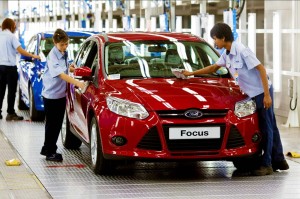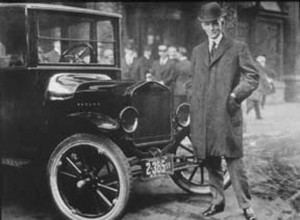
Ford's 350 millionth vehicles, a red Focus sedan, rolls down the assembly line in Rayong, Thailand today.
It looked pretty much like any other Ford Focus as it rolled down the maker’s assembly line in the Bangkok suburb of Rayong early Friday morning. But the compact sedan marked a major milestone for the automaker – as the 350 millionth vehicle has produced in its nearly 110-year history.
The event was significant for more than just the raw numbers. The sedan symbolizes the dramatic transformation that has been shaking up Ford as it evolves from a worldwide network of regional fiefdoms into an integrated system producing global products like the Focus.
Equally noteworthy is the fact that the Rayong plant was chosen to mark the occasion. The Asian market has become increasingly important to Ford – and its rivals. The maker will soon operate nine plants in the region – including the newest of six in China for which Ford CEO Alan Mulally helped break ground earlier this week.
“Producing 350 million vehicles is equivalent to producing one vehicle every 10 seconds for our 109-year history. If placed end to end, the vehicles would stretch to the moon and back – twice,” said John Fleming, Ford executive vice president of global manufacturing, in a statement.
(To put the number into perspective, however, there are an estimated 800 million to perhaps 1 billion motor vehicles on roads around the world today, about 240 million of them in the U.S. The industry has been producing more than 50 million annually and some estimate that could jump to 80 million by decade’s end.)
It took Henry Ford three tries before he got his business plan right, rolling out the first in a series of primitive models in 1903 from a small plant in Detroit. Focusing on the potential of a mass market, rather than the luxury niches targeted by most manufacturers of the era, the industry pioneer quickly outgrew a facility on Piquette Street, in Detroit, and set up a sprawling new, multi-story plant in what had been the farm fields of nearby Highland Park.
Desperate to cut costs and squeeze more of the new Model T “Tin Lizzies” out the door, Ford and his team eventually came up with the concept of the moving assembly line. It is generally seen as one of the most important industrial breakthroughs of the 20th Century – though it actually borrowed from a concept long used in Chicago slaughterhouses.
Recognizing demand for an affordable automobile was not bound by American borders, Henry Ford soon set up shop in Canada, then England. Today, the maker sells vehicles in more than 100 countries worldwide.
Yet, until relatively recently, Ford Motor Co. operated more as a network of regional fiefdoms than a truly global empire. That began to change when Alan Mulally, until then a senior executive at Boeing, signed on as Ford’s new CEO. He ordered the sell-off of various European luxury brands, including Volvo and Jaguar, to focus on Ford’s core brands – while also shutting down the struggling Mercury.
Perhaps more important was the decision to shift from a strategy that had each region produce its own products. Until recently, the Focus models produced in Europe and the U.S., for example, had only a handful of parts and components in common. Today, they share more than 80%.
While there are still some regional products – such as the big F-Series pickups popular in the States – just nine core models will soon dominate Ford’s global production and sales network, accounting for a projected 85% of its total sales.
The Focus is already the most popular. It generated 489,616 sales during the first half of 2012, according to data from IHS Automotive. Significantly, that put it more than 27,000 units ahead of the competing Toyota Corolla.
(Can Focus maintain that lead and topple king-of-the-hill Corolla as the world’s best-selling car this year? Click Here for more.)
Much of that demand now comes from Asia. The Rayong plant launched production of the newest Ford Focus model just two months ago.
That plant produces a variety of different models including the Focus and new Ranger compact pickup – which also is symbolic of Mulally’s One Ford strategy. Flexible assembly lines are better positioned to adapt to changing market conditions as demand for an older model dips and sales of a newer offering climbs.
At the beginning of the new Millennium, Ford was betting heavily on the Thai facility, so much so it was late to the party when neighboring China began to open up to foreign automotive investment. Rivals General Motors and Volkswagen beat Ford to the punch and it is now racing to play catch-up.
Earlier this week, CEO Mulally and some of his key lieutenants were in Chongqing for the groundbreaking of what will be Ford’s sixth plant in what is now the world’s largest auto market. The maker hopes to double its annual sales in China by mid-decade.
Among the vehicles Ford is rolling out in China are the Kuga – the name used in most of the world for what Americans know as the Escape – and the Focus.
“The Focus is attracting many new customers to the Ford brand for the very first time, particularly in Asia where we are growing every day,” said the maker’s global marketing czar Jim Farley.
Ford is hoping that growth in emerging markets in Asia – as well as India, Latin America and Africa – will help offset its struggles in more established regions. That notably includes Europe where it expects to lose more than $1 billion this year.

